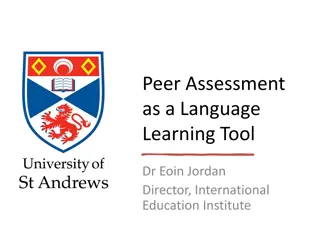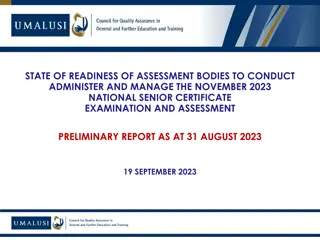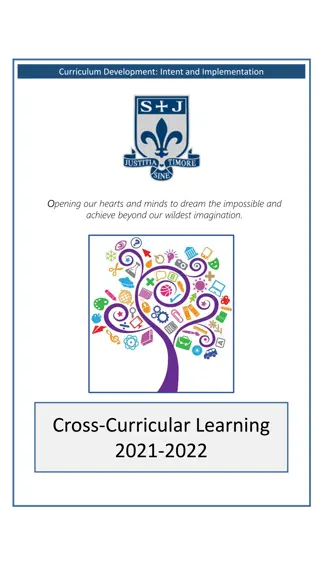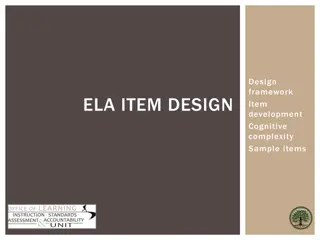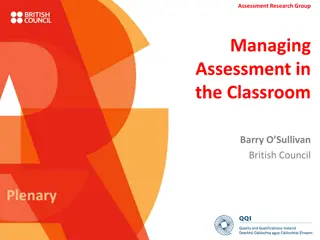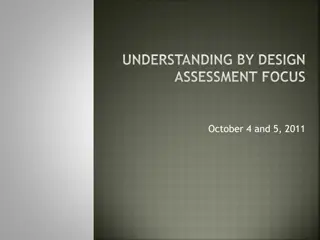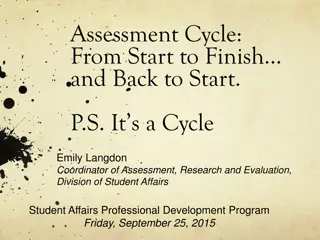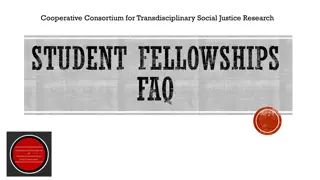Comprehensive Assessment in ACT: A Transdisciplinary Approach
Comprehensive Assessment in Assertive Community Treatment (ACT) involves a transdisciplinary team conducting detailed evaluations to develop unified service plans. Participants are actively engaged in all stages of planning and delivery, with team members and participants collaboratively developing and monitoring individualized plans. Regular team meetings facilitate information sharing, skill transfer, and interdisciplinary collaboration. The initial assessment determines eligibility and needs, while the comprehensive assessment must be done within specific timelines and covers various domains like psychiatric history, physical health, substance abuse, education, employment, social functioning, and more.
Download Presentation

Please find below an Image/Link to download the presentation.
The content on the website is provided AS IS for your information and personal use only. It may not be sold, licensed, or shared on other websites without obtaining consent from the author. Download presentation by click this link. If you encounter any issues during the download, it is possible that the publisher has removed the file from their server.
E N D
Presentation Transcript
ACT ACT COMPREHENSIVE COMPREHENSIVE ASSESSMENT ASSESSMENT Oregon Center of Excellence for Assertive Community Treatment
ACT working as a transdisciplinary team Team members conduct comprehensive assessment together ACT participants are active in all phases of treatment planning and service delivery Team members and participants develop plans together The team is jointly responsible for implementing and monitoring the plan Regular team meetings with ongoing transfers of information, knowledge and skills shared among team members Team members make a commitment to teach, learn, and work together across disciplinary boundaries in all aspects to implement unified service plans An integral component of working across disciplines and team building ACT recipient/client participation Service plan development Service plan implementation Lines of communication Guiding philosophy Staff development
Initial Assessment The initial assessment evaluates appropriateness and eligibility for ACT service, documenting initial diagnosis, reviews immediate needs for service First service plan is often generic due to limited information about ACT participant and limited engagement Serves as authorization for service
Comprehensive Assessment Usually must be completed within 30 days of initial enrollment and then every 12 months thereafter Team leader assigns who is to complete sections of the comprehensive assessment or the assessment is assigned to an ITT who determines which team members complete assigned parts
ACT Comprehensive Assessment Elements of Comprehensiv Assessment (NAMI, Allness and Knoedler, 2003) Team members conduct comprehensive assessment together ACT psychiatrist/ QMHP or team leader/ nurse ACT nurse Part 1: Psychiatric History, Mental Status and Diagnosis, medication history Part 2: Physical Health ACT substance abuse specialist Part 3: Use of Drugs or Alcohol ACT employment specialist Part 4: Education and Employment and Income Part 5: Social Development and Functioning, Legal History A team member interested and skillful in attainment/restoration of social/interpersonal skills and functioning A team member with training and interest in completing the ADL assessment Part 6: Activities of Daily Living Part 7: Family Structure and Relationships, Trauma History Part 8: Cultural , Ethnic and Spiritual Context, Strengths A team member interested and knowledgeable about ACT participant family A team member interested and knowledgeable about ACT participant cultural background
Goals of comprehensive assessment are: To reconstruct and evaluate what the individual has been through in his/her life while living with a mental illness To form a therapeutic alliance with each ACT consumer To work with the individual on his/her own terms by not rushing to complete the comprehensive assessment but to view the assessment as an ongoing practice To help the individual identify personal needs and aspirations and instilling hope for recovery To understand the individual on various individual and social levels in order to develop an individualized treatment plan For the nurse and psychiatrist to evaluate medical needs and interventions that are to be addressed in treatment
Comprehensive Assessment Gather and analyze information from: ACT participant Interviews with Family and support system Past inpatient and outpatient records both psychiatric and substance abuse treatment Physician records, treatment plan reviews discharge summaries Other records school records, medical treatment military service Other interviews with past employers or service providers
Strengths Assessment and Resources Core gifts Hope optimism Abilities and talents Accomplishments Values and traditions Unique individual attributes Natural supports Resources Interest, hopes, dreams, motivations
ITT What is the Individual Treatment Team (ITT) How do you use the ITT
ITT composition Usually a subset of team members (3-4) Typically the ITT remains intact during the course of a planning period but are modified as the needs of and plans change (may change as often as every three months)
Assignment of ITT Assignment of ITT can facilitate more efficient use of team resources and better person-centered care More strategic use of staff expertise Emphasize unique areas of expertise (supported housing, assistance with activities of daily living, trauma therapy) As needs of the ACT participant changes so does the composition of the ITT
Function of ITT 1) be most knowledgeable about the client s life, circumstances, goals and desires; 2) collaborate with the client to complete assessments, develop and write the treatment plan; 3) offer options and choices in the treatment plan; 4) ensure that immediate changes are made as a client s needs change; 5) advocate for the client s wishes, rights, and preferences.
Clinical cycle as an ACT team Assess Treatment plan Serve Evaluate
Assess Each ACT participant receives an annual comprehensive assessment that assesses strengths, goals, treatment needs, and other life domains in a holistic way However, every client contact is an assessment of how a person is doing and needs to adjust the plan of care when necessary
Treatment Plan The ACT team along side the ACT participant develops a person centered treatment plan that addresses all life domains specified as important to the consumer Treatment plan is a working document that needs to be undated and changed as individuals needs change
Serve The ACT team provides services needed to assist consumers achieve their goals Provide intentional targeted interventions that will meet individual s needs
Evaluate Effectiveness and Daily ACT meeting Check daily that the plan is being implemented Check daily to see whether the plan or services are accomplishing intended goals If plan and or services are not working, change it Discuss new strategies Team engages in creative problem solving
Websites with great resources https://www.omh.ny.gov/omhweb/nyscri/ assessmentaddendums.html http://cchealth.org/mentalhealth/clinical- documentation/ http://www.centerforebp.case.edu/client- files/pdf/iddtclinicalguide.pdf http://www.ncbi.nlm.nih.gov/books/NBK6 4197/pdf/Bookshelf_NBK64197.pdf
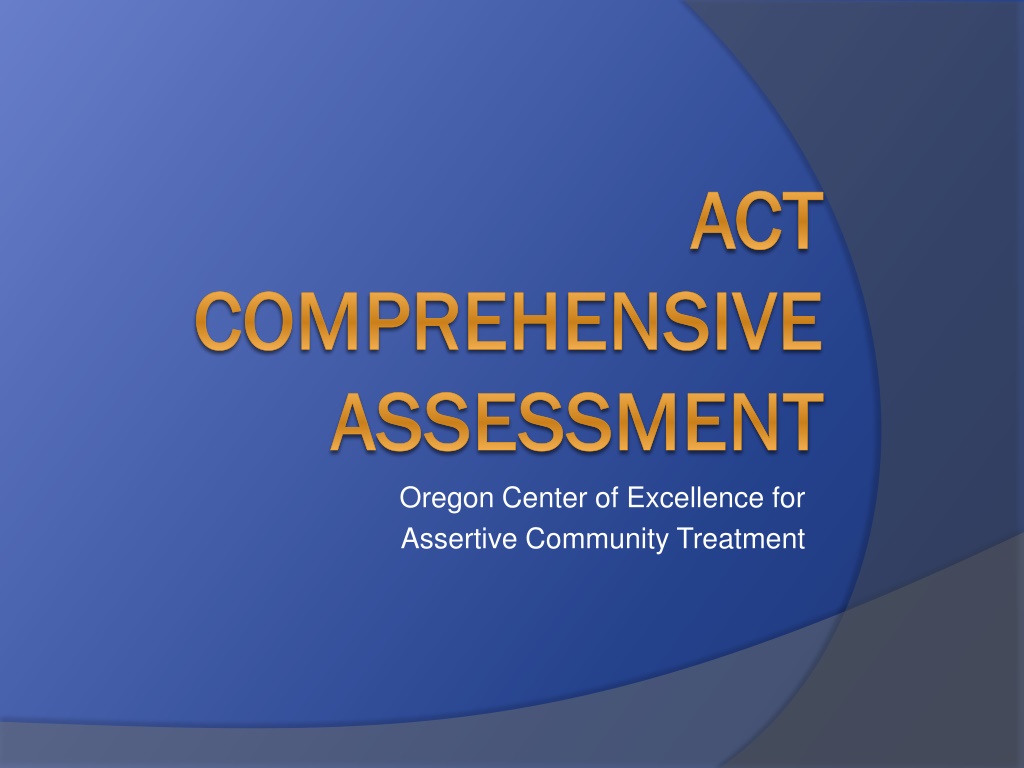
 undefined
undefined








